The ASUS Maximus VIII Extreme Review: The Other $500 Option
by Ian Cutress on April 7, 2016 9:00 AM EST- Posted in
- Motherboards
- Gaming
- Asus
- ROG
- Skylake
- Z170
- Thunderbolt 3
CPU Performance, Short Form
For our motherboard reviews, we use our short form testing method. These tests usually focus on if a motherboard is using MultiCore Turbo (the feature used to have maximum turbo on at all times, giving a frequency advantage), or if there are slight gains to be had from tweaking the firmware. We leave the BIOS settings at default and memory at JEDEC (DDR4-2133 C15) for these tests, making it very easy to see which motherboards have MCT enabled by default.
Video Conversion – Handbrake v0.9.9: link
Handbrake is a media conversion tool that was initially designed to help DVD ISOs and Video CDs into more common video formats. For HandBrake, we take two videos (a 2h20 640x266 DVD rip and a 10min double UHD 3840x4320 animation short) and convert them to x264 format in an MP4 container. Results are given in terms of the frames per second processed, and HandBrake uses as many threads as possible.
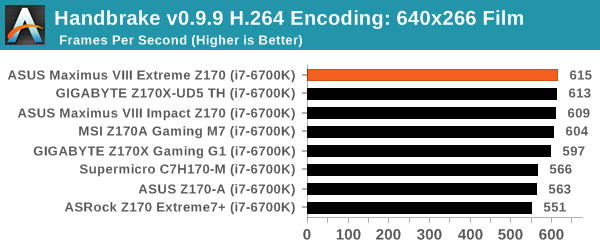
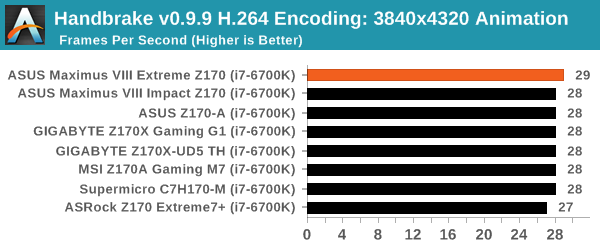
Compression – WinRAR 5.0.1: link
Our WinRAR test from 2013 is updated to the latest version of WinRAR at the start of 2014. We compress a set of 2867 files across 320 folders totaling 1.52 GB in size – 95% of these files are small typical website files, and the rest (90% of the size) are small 30 second 720p videos.
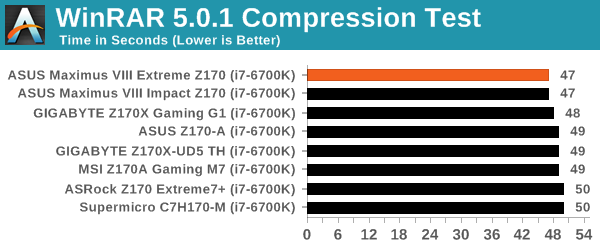
Point Calculations – 3D Movement Algorithm Test: link
3DPM is a self-penned benchmark, taking basic 3D movement algorithms used in Brownian Motion simulations and testing them for speed. High floating point performance, MHz and IPC wins in the single thread version, whereas the multithread version has to handle the threads and loves more cores. For a brief explanation of the platform agnostic coding behind this benchmark, see my forum post here.
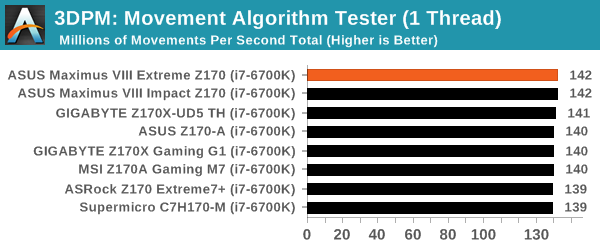

Rendering – POV-Ray 3.7: link
The Persistence of Vision Ray Tracer, or POV-Ray, is a freeware package for as the name suggests, ray tracing. It is a pure renderer, rather than modeling software, but the latest beta version contains a handy benchmark for stressing all processing threads on a platform. We have been using this test in motherboard reviews to test memory stability at various CPU speeds to good effect – if it passes the test, the IMC in the CPU is stable for a given CPU speed. As a CPU test, it runs for approximately 2-3 minutes on high end platforms.
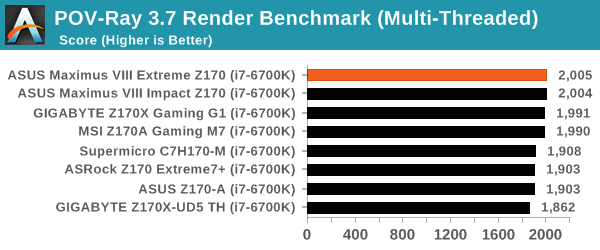
Synthetic – 7-Zip 9.2: link
As an open source compression tool, 7-Zip is a popular tool for making sets of files easier to handle and transfer. The software offers up its own benchmark, to which we report the result.
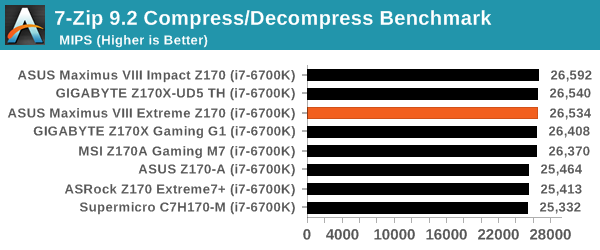










70 Comments
View All Comments
saratoga4 - Thursday, April 7, 2016 - link
>if you care about audio you're exiting it on hdmi anywayMaybe for speakers, but not headphones. Good headphone amps on receivers are surprisingly rare. HDMI replaces line out for a lot of people, which is why its unfortunate that reviewers typically test line out and ignore headphone out.
Impulses - Friday, April 8, 2016 - link
If you're only using headphones you can still do TOSlink out to an excellent outboard DAC/amp for $150-300 (less than an AVR) and it'll blow away anything that could be built into a mobo... Or just get a Xonar STX for $150, still pretty solid and the amp will still be better than anything on a mobo.jptech7 - Friday, April 8, 2016 - link
For headphone equipment, most are using USB audio or TOSLINK in my experience, but the idea is the same. I still respect the effort that Asus put into the audio system.Ubercake - Friday, April 8, 2016 - link
Even a $300 pro-level Asus board has exceptional on-board sound; better than many soundcards even in the $100-$150 range. In my opinion, the price on most sound cards is way too high, though the low demand due to people using great on-board sound might be the reason for the high price.Silma - Thursday, April 7, 2016 - link
This motherboard only makes sense for people who need low DPC latency, so mostly people in the audio/music industry.Otherwise the market is flooded with excellent 150 $ motherboards, which leave 350 $ to spend on a better graphic card, NVMe SSD, more memory or whatever makes sense for the user.
willis936 - Thursday, April 7, 2016 - link
Dude it's 2016.Dr. Swag - Thursday, April 7, 2016 - link
I know you guys are hard at work on all the different articles and reviews and I appreciate it, but just wondering where is the article you guys promised 2 months ago on a review and ipc analysis of the Athlon x4 845? I'm really looking forward to that since depending on how big of an improvement Excavator is it could also affect Zen (since AMD said Zen is Excavator+ 40% or more), and I'm super excited for Zen. It's been nearly 2 months, and I know the x4 845 wasn't out then but it's been on the market for at least a month now. Just curious on how far you guys are on that and if it is coming out soon.If you don't know what I'm talking about and somehow completely forgot about it, here is the link to the original comment:
http://www.anandtech.com/comments/10000/who-contro...
ghanz - Thursday, April 7, 2016 - link
Seconded.extide - Thursday, April 7, 2016 - link
On page one, the Motherboard Comparison table is all screwed up. If you pick Asrock Z170 Extreme 7+, you get the stats for the MSI Gaming M7. If you pick the MSI Gaming M7, you get the stats of something else. If you pick the Asus Z170A you get the stats for the Asrock Extreme 7+. Please fix!extide - Thursday, April 7, 2016 - link
I am sure they are all messed up, those are only the ones I knew were wrong off the top of my head.